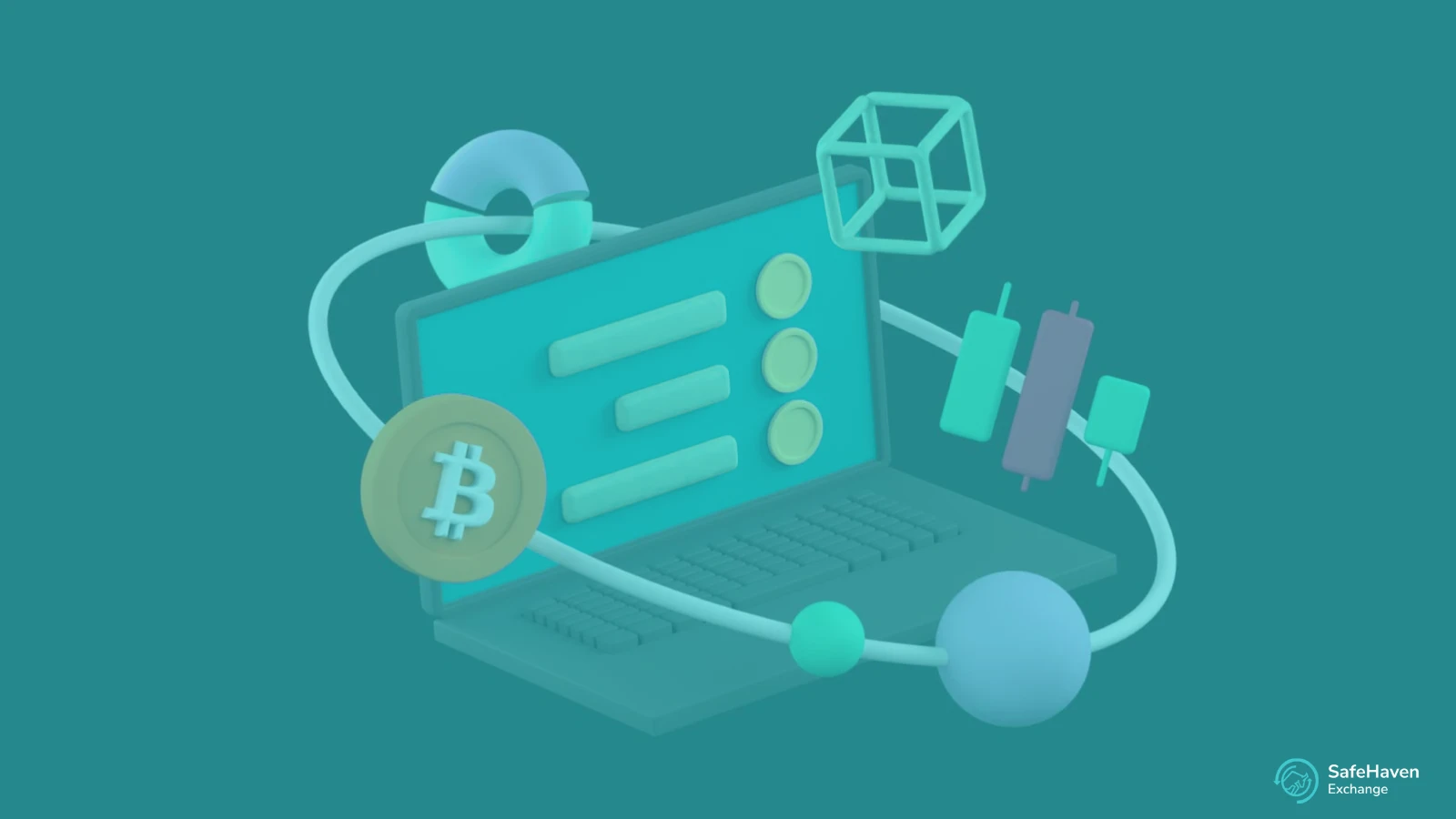When trading cryptocurrency, understanding the spread can make a significant difference to your bottom line. While it may seem like a minor detail, spreads are an unavoidable cost that directly affects your profits, especially in the volatile world of crypto trading. In this guide, we’ll break down what spreads are, why they exist, and how you can manage them to trade smarter and more efficiently.
At SafeHaven Exchange, we believe in making crypto trading accessible, transparent, and fair. While spreads are inherent to the market, we work hard to ensure they reflect real market conditions without unnecessary fees eating into your profits. Let’s explore the essential elements of spreads and how you can minimize their impact on your trades.
What is a Spread in Crypto Trading?
A spread in crypto trading is the difference between the bid price (what a buyer is willing to pay) and the ask price (what a seller is willing to accept). This difference represents a hidden cost that traders must account for when executing a trade. The spread acts as a barrier to immediate profit, and depending on market conditions, it can be quite significant.
In essence, the spread is an inherent part of crypto trading and reflects the market’s liquidity and volatility. Understanding this difference is crucial to managing your trading strategy effectively.
Why Spreads Matter in Crypto Markets
In traditional financial markets, spreads are essential for two key reasons:
- Compensating Market Makers: These spreads help liquidity providers (market makers) manage the risk associated with holding volatile assets.
- Reflecting Market Conditions: Spreads widen during periods of high volatility or low liquidity, signaling the health of the market and indicating potential risk.
In the crypto world, where markets are decentralized, fragmented, and highly volatile, spreads play an even more pivotal role. Traders must be aware that spread costs can shift quickly, especially in less liquid markets or during times of increased market activity.
How Do Spreads Impact Your Profits?
The spread is one of the most direct costs you will face as a crypto trader. It impacts your entry and exit points, as the price you buy at (ask price) is always slightly higher than the price you can sell at (bid price). This means that as soon as you make a trade, you’re already at a loss equal to the spread.
For high-frequency traders or those dealing in large volumes, even a small spread can add up quickly and significantly reduce profit margins. Therefore, understanding how to calculate and manage the spread is essential for maximizing your returns.
How to Calculate the Spread
To calculate the spread in crypto trading, simply subtract the bid price from the ask price:
Spread = Ask Price – Bid Price
For a clearer perspective, traders often express the spread as a percentage of the ask price:
Spread % = (Spread / Ask Price) × 100
Example: The Impact of Spreads on Bitcoin Trading
Let’s break down how spreads can affect a Bitcoin trade to illustrate their impact more clearly.
Imagine the following market conditions:
- Bid price (buying price): €99,000
- Ask price (selling price): €99,100
- Spread = €99,100 – €99,000 = €100
1. Entering a Trade
If you decide to buy 1 BTC at the ask price of €99,100, you are immediately facing a €100 loss when you buy, because the current market value is based on the bid price of €99,000. If you tried to sell right away, you’d be at a loss equal to the spread.
To break even, the price of Bitcoin must increase by at least €100.
2. Exiting the Trade
Let’s assume Bitcoin’s price increases, and the new prices are:
- New Bid price: €100,000
- New Ask price: €100,100
Now, if you sell at the new bid price of €100,000, your profit would be:
Profit = €100,000 – €99,100 = €900
At this point, you’ve accounted for the spread and made a profit. Understanding the role of the spread in your trades ensures that you can properly assess potential profit and loss before entering or exiting a position.
Why Are Crypto Spreads Higher Than in Traditional Markets?
Compared to traditional financial markets, crypto markets tend to have higher spreads. There are several reasons for this:
- Market Fragmentation: Cryptocurrencies trade across various platforms and exchanges, leading to less liquidity and more price discrepancies between them.
- High Volatility: Cryptocurrencies can experience massive price swings, so liquidity providers charge wider spreads to cover the increased risk.
- Lack of Regulation: Unlike traditional financial assets, crypto markets are still relatively unregulated and can be affected by market manipulation or sudden price movements.
While these factors contribute to higher spreads in crypto trading, it’s crucial to understand that this isn’t necessarily a disadvantage. It simply means that spreads reflect real market conditions, and traders must be mindful of them when executing trades.
How to Minimize the Impact of Spreads
While it’s impossible to completely avoid spreads, there are several strategies to minimize their effect on your profits:
- Trade During Stable Market Conditions: The spread tends to narrow during periods of lower volatility. Avoid trading during high volatility events like major news releases or significant market shifts.
- Use Lower Leverage: High leverage increases the spread because platforms account for the increased risk. By using lower leverage, you can help manage the spread more effectively.
- Monitor Spread Warnings: On platforms like SafeHaven Exchange, you’ll be alerted when the spread exceeds certain thresholds. This allows you to pause or reconsider trades during times of high spread.
These simple tips can help reduce the negative impact of spreads, ensuring that you can trade more efficiently and profitably.
Spread Betting: A Risky Alternative
Spread betting involves speculating on price movements without owning the underlying asset. It’s a high-risk strategy that uses leverage and can be unpredictable, making it a less reliable choice for many traders.
At SafeHaven Exchange, we prioritize offering more transparent and secure ways to trade. Instead of spread betting, we focus on providing derivatives—financial contracts tied to the real market value of an asset—allowing you to trade without taking on unnecessary risks.
How SafeHaven Exchange Helps You Navigate Spreads
Although you can’t avoid spreads altogether, SafeHaven Exchange works hard to make them as transparent and fair as possible. We display the exact spread when you enter or exit a position, so you know exactly how much you’re paying. Our zero-commission trading policy ensures that you’re only paying the spread, without any hidden fees eating into your profits.
We also notify you when spreads exceed a set threshold, so you can make informed decisions about your trades.
Why Spreads Are Necessary for Fair Trading
Without spreads, traders could exploit price discrepancies that wouldn’t reflect the true value of an asset. Spreads act as a safeguard, ensuring fair trades that reflect the true cost of executing a transaction.
At SafeHaven Exchange, we maintain these spreads to ensure market integrity and prevent manipulation, keeping the trading environment fair and transparent for all traders.
Conclusion: Spreads Are a Natural Part of Crypto Trading
In summary, spreads are an unavoidable but manageable cost of crypto trading. They directly affect your profit margins, but with the right strategies, you can minimize their impact and optimize your trades. At SafeHaven Exchange, we are committed to providing a transparent, fee-free trading environment where spreads are fair and reflective of real market conditions.
Ready to take your crypto trading to the next level? SafeHaven Exchange offers a platform designed to help you trade with ease, transparency, and confidence. Join us today and experience a smarter way to trade cryptocurrencies.
FAQ
What is a spread in cryptocurrency trading?
A spread in crypto trading is the difference between the bid price (what buyers are willing to pay) and the ask price (what sellers are willing to accept). It represents the cost of executing a trade.
How does the spread affect profit margins?
The spread reduces your potential profit margin because you must overcome the cost of the spread before you can make a profit. A wider spread means a larger portion of your gains goes towards covering this cost.
What factors influence the spread in crypto trading?
Spreads are primarily influenced by market volatility and liquidity. Higher volatility and lower liquidity typically lead to wider spreads.
How can I minimize the spread in crypto trading?
You can minimize the impact of spreads by trading during more stable market conditions, using lower leverage, and monitoring spread warnings to avoid trading when spreads are unusually high.







